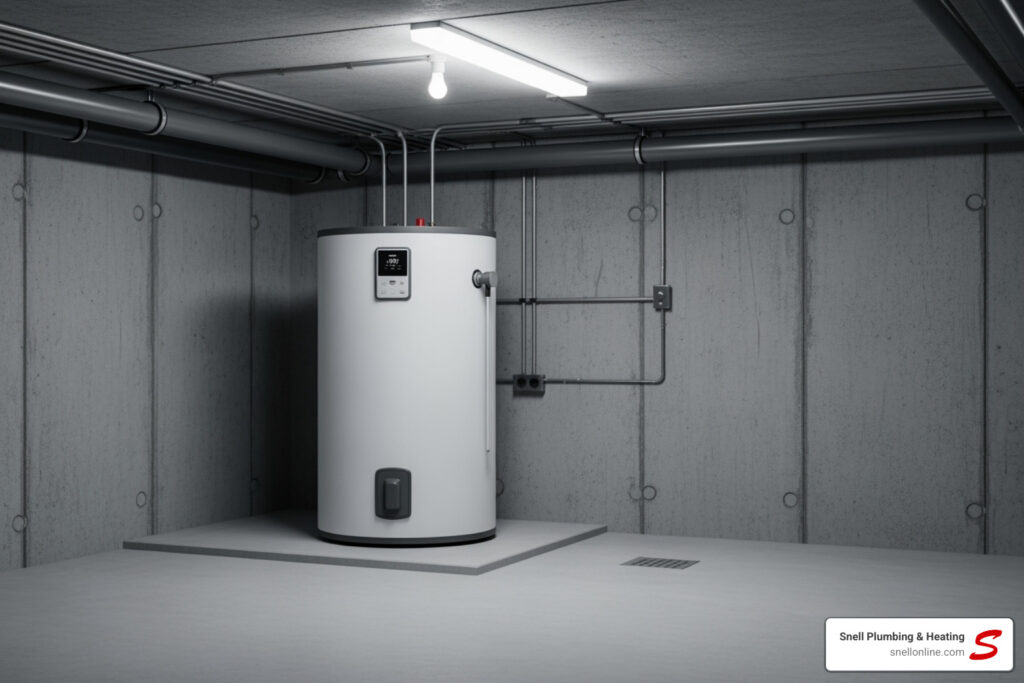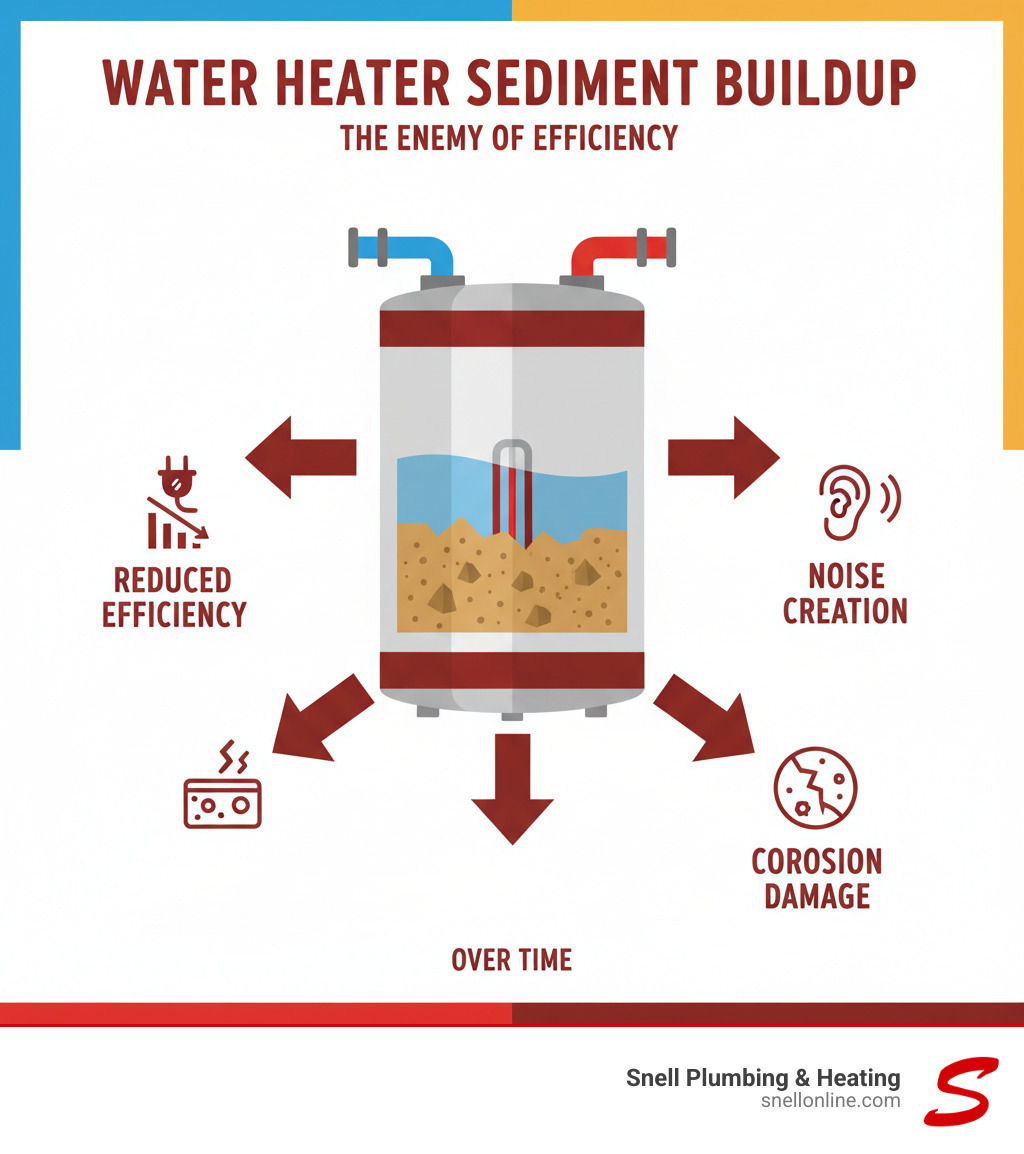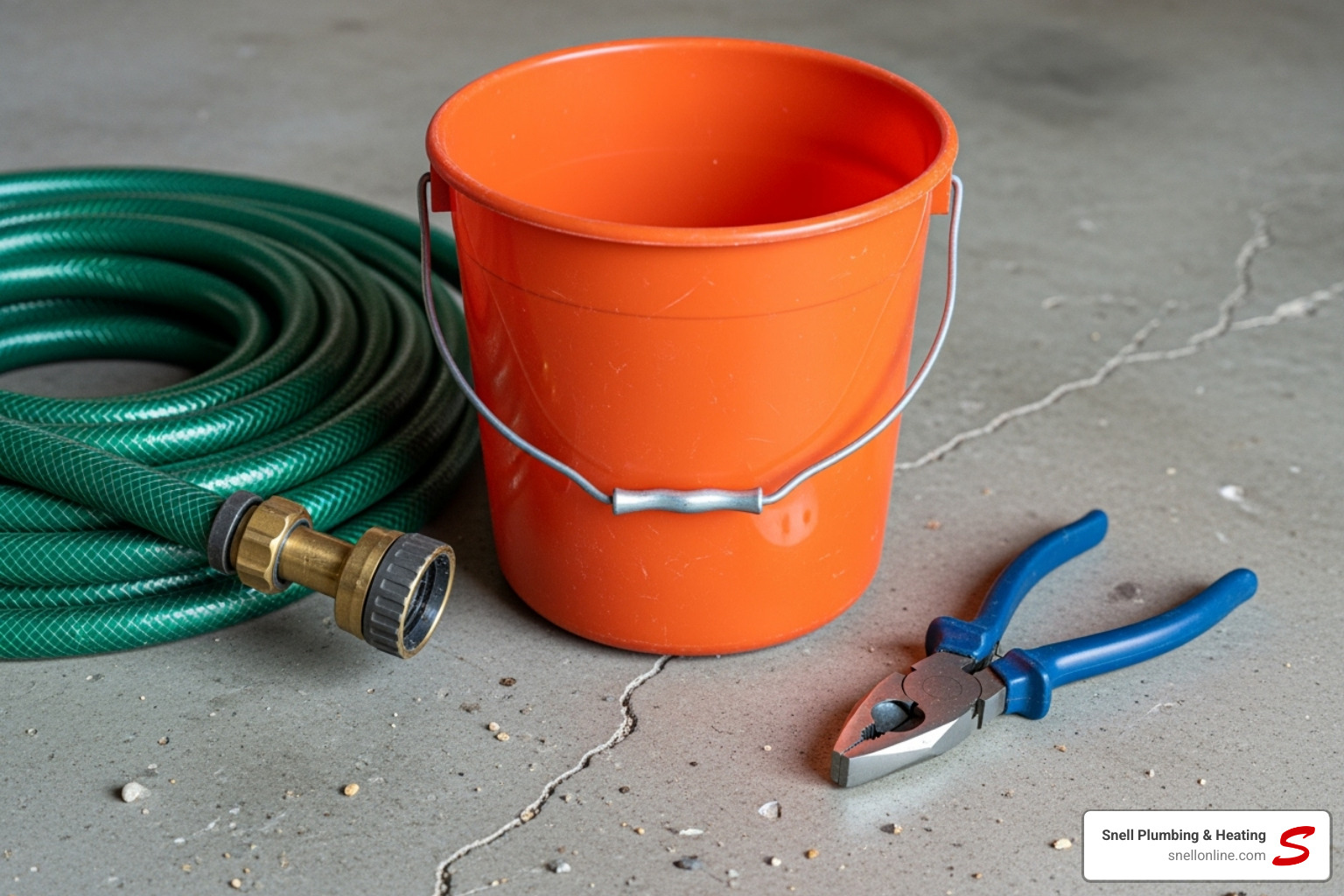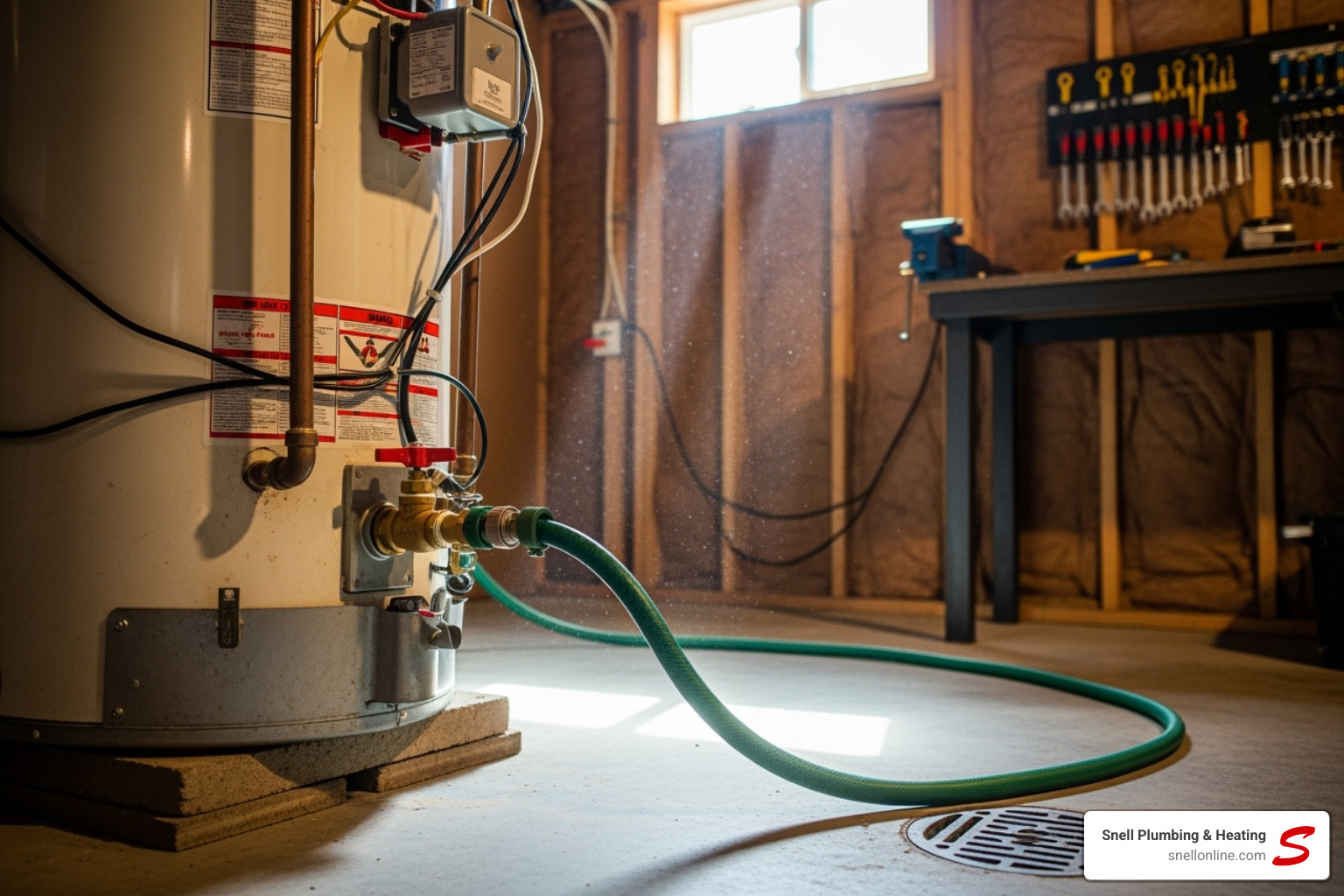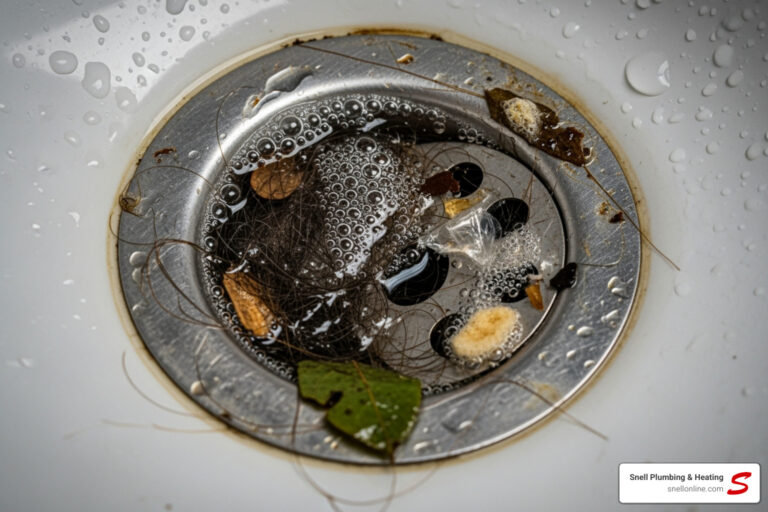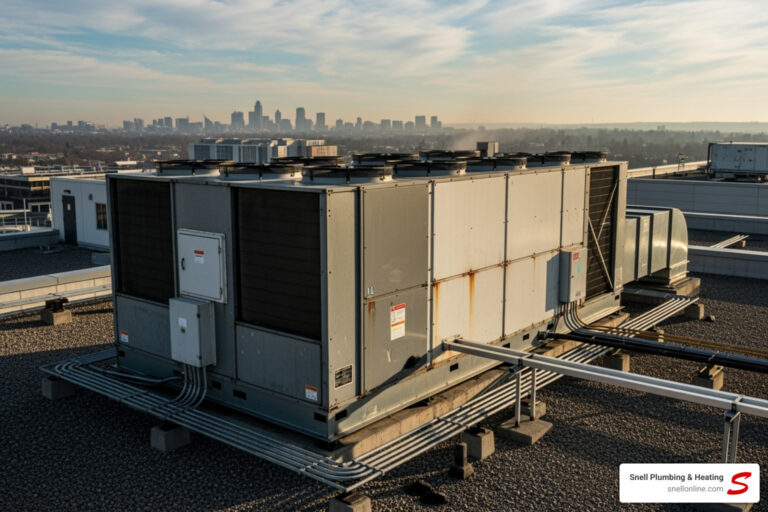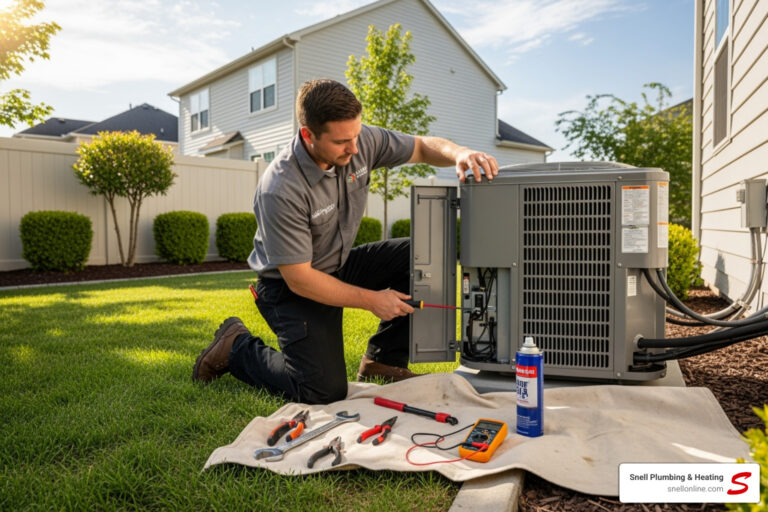Why Regular Water Heater Maintenance Keeps Your Home Running Smoothly
Flushing your water heater regularly is key to preventing sediment buildup, extending your unit’s lifespan, and maintaining energy efficiency. Here’s what you need to know:
Quick Answer for Homeowners:
- Frequency: Flush annually (more often with hard water).
- Best Time: After any municipal water main flushing in your area.
- Benefits: Removes mineral deposits, prevents noise, and improves efficiency.
- Safety First: Turn off power/gas and let water cool before starting.
- When to Call a Pro: For units over 10 years old or with severe buildup.
Your water heater works hard every day. Over time, minerals like calcium and magnesium from the water supply settle at the bottom of the tank. This sediment buildup is the enemy of efficiency.
Many municipalities flush their water mains annually, which can stir up extra sediment that finds its way into your home’s plumbing. It’s a good practice to flush your water heater after these programs are completed.
Plumbers recommend flushing your water heater tank at least once a year. This simple task removes sediment that causes rumbling noises, reduces heating efficiency, and can lead to premature tank failure.
Ignoring this maintenance costs you money. Sediment forces your system to work harder and use more energy. In severe cases, the buildup can cause your tank to corrode from the inside out.
Why Flushing Your Water Heater is Crucial
Behind the scenes, your water heater faces a constant challenge. Your water contains minerals like calcium and magnesium that, while harmless to drink, settle at the bottom of the tank over time, creating a thick layer of sediment.
This situation can be worsened by annual municipal water main flushing. While necessary for water quality, this process can stir up extra sediment that finds its way into your home’s plumbing.
Once sediment builds up, it becomes a troublemaker. It forms a barrier between the heating element and the water, forcing your system to work overtime. This leads to several problems:
- Popping and Rumbling Noises: These sounds are caused by steam bubbles trapped under the sediment layer. If your water heater is noisy, it’s a clear sign it needs attention. You can learn more about what these sounds mean on our page about water heater noises.
- Internal Corrosion: Sediment creates pockets where corrosive elements concentrate, eating away at your tank from the inside. This weakens the tank walls and can lead to premature failure.
The Risks of Neglecting Your Water Heater
Putting off water heater maintenance can lead to serious issues:
- Tank Damage and Leaks: Internal corrosion can weaken the tank until it fails, causing anything from a slow leak that damages flooring to a major flood in your basement or utility room.
- Higher Energy Bills: The insulating layer of sediment forces your water heater to run longer, burning more energy and increasing your utility costs.
- Health Concerns: If water temperatures drop too low due to poor maintenance, harmful bacteria like Legionella can grow in the tank.
- Inconsistent Hot Water: Sediment buildup can lead to frustrating temperature fluctuations, leaving you with lukewarm showers or dishes that don’t get clean.
How Often Should You Flush Your Water Heater?
For most homes, the answer is simple: flush your water heater once a year. This aligns with recommendations from most plumbing professionals.
However, you may need to adjust this schedule based on a few factors:
- Hard Water: If you have hard water (indicated by white spots on dishes or soap scum), minerals build up faster. In this case, flushing every six months is a good idea.
- Manufacturer’s Guidance: Always check your owner’s manual for specific recommendations for your model. Following the manufacturer’s advice also helps protect your warranty.
- Warning Signs: Your water heater will tell you when it needs a flush. Popping or rumbling sounds, rust-colored water, or a drop in hot water supply are all clear signals that it’s time for maintenance.
If you’re wondering about other maintenance questions, we cover many common concerns in our Plumbing & HVAC FAQs. Proactive maintenance is always better than an emergency repair.
Your Step-by-Step Guide to Flushing a Water Heater
Flushing your water heater is a straightforward project that most homeowners can handle. With the right preparation, you can have your unit running more efficiently in just a few hours.
Before starting, gather your supplies: a garden hose, a bucket, and pliers or a flathead screwdriver for the drain valve. The main difference between gas and electric units is the shutoff procedure: turn the control dial to “PILOT” or “OFF” for gas, and flip the circuit breaker for electric.
For additional guidance, the Energy Trust of Oregon has a helpful resource on drain, flush and save: Water heater maintenance 101.
Step 1: Preparation and Safety
Safety is non-negotiable when dealing with hot water and electricity or gas. Follow these steps carefully to avoid injury.
- Turn Off Power/Gas: For an electric unit, flip the corresponding breaker in your electrical panel to “OFF.” This prevents the elements from burning out in an empty tank. For a gas unit, turn the gas control valve to “PILOT” or “OFF.”
- Shut Off Water: Turn the cold water supply valve (usually a blue handle on top of the tank) clockwise until it stops.
- Let Water Cool: This is critical to prevent scalding. Hot water can cause serious burns in seconds. It’s best to turn off the heater the night before. Otherwise, wait at least 4-6 hours for the water to cool.
- Open a Hot Water Faucet: Open a hot water tap in a nearby tub or sink. This breaks the vacuum in the system and helps the tank drain completely.
Step 2: Draining and Flushing the Tank
Now it’s time to remove the built-up sediment.
- Connect the Hose: Attach your garden hose securely to the drain valve at the bottom of the tank.
- Route the Hose: Run the other end of the hose to a floor drain or outside. Avoid draining onto concrete, as the minerals can leave stains.
- Open the Drain Valve: Use your pliers or screwdriver to open the valve. The initial water will likely be murky and full of particles—this is the sediment you want to remove.
- Flush the Tank: Once the tank is empty, close the drain valve and briefly open the cold water supply for a minute. This stirs up any remaining sediment. Drain the tank again.
- Repeat: Repeat this fill-and-drain process until the water runs clear. This may take 3-4 cycles for tanks with heavy buildup.
- Clogged Valve Tip: If the valve clogs, close it and briefly turn on the cold water supply. The pressure should dislodge the blockage.
Step 3: Refilling and Restarting
You’re almost done. Let’s get your water heater back in service.
- Close the Drain Valve: Close the valve tightly and disconnect the hose.
- Refill the Tank: Fully open the cold water supply valve. The tank will take 15-30 minutes to fill.
- Purge the Air: Leave the hot water faucet open until water flows smoothly without any sputtering. This removes air pockets from the system. If you still have issues, see our guide on what to do if your water heater is not producing hot water.
- Restore Power: For electric units, flip the breaker back to “ON.” For gas units, turn the control dial to “ON” and relight the pilot if necessary, following the manufacturer’s instructions.
It will take 30-60 minutes for the water to heat up. Afterward, you should enjoy quieter operation and better efficiency. You’ve just completed a vital maintenance task that can extend your water heater’s life and save you money.
Beyond Flushing: Key Water Heater Health Checks
Flushing is vital, but a few other checks will keep your water heater in top shape.
- Check the Anode Rod: This “sacrificial” metal rod hangs inside your tank to attract corrosive elements, protecting the tank walls from rust. It’s designed to wear out. Check it every 3-5 years and replace it if it’s significantly degraded. If you don’t, your tank itself will start to corrode.
- Test the Pressure Relief Valve: This critical safety device prevents the tank from over-pressurizing. Test it annually by lifting the lever for a few seconds. Water should flow out and stop when you release it. If it leaks or doesn’t release water, it needs immediate replacement. Learn more about pressure relief valve problems.
- Adjust the Temperature: Set your water heater to 120°F for a good balance of safety and efficiency. This temperature reduces the risk of scalding. While some recommend higher temperatures (140°F) to prevent bacteria like Legionella, this increases burn risk. If you choose a higher setting, install anti-scald devices at faucets and showers.
Signs Your Water Heater Needs Repair or Replacement
Knowing when to repair versus replace can save you money and hassle. Here’s what to look for:
- Age: Tank-style water heaters last about 10 years; tankless models can last 20 or more. If your unit is over a decade old and has problems, replacement is often the smarter choice.
- Leaking Tank: Water pooling around the base of your unit usually means the tank has failed and needs to be replaced.
- Rust-Colored Water: This can indicate a worn-out anode rod or a corroding tank. If a new anode rod doesn’t fix it, the tank is likely rusting from the inside.
- Persistent Noises: Rumbling or popping that continues after a thorough flush may signal internal damage.
- Insufficient Hot Water: This could be a faulty heating element, but if problems persist, it might be time for an upgrade.
When to Call a Pro for Water Heater Service
While DIY flushing is great, some situations require a professional.
- Old or Unmaintained Heaters: Flushing a water heater over 10 years old for the first time can be risky. Sediment may be plugging small leaks, and removing it could cause the tank to fail. A pro can assess if it’s safe to flush.
- Stuck or Clogged Drain Valve: Don’t force a valve that won’t budge. Technicians have the right tools to handle it without damaging the tank.
- Severe Sediment: If the water won’t run clear after several flush cycles, you have heavy buildup that needs professional attention.
- You’re Uncomfortable with the Job: If you’re not confident in the process or run into unexpected issues, calling a professional is the safest choice. Our team is always ready to help. You can trust our technicians for water heater repair.
Frequently Asked Questions about Water Heater Maintenance
Here are answers to some of the most common questions we receive about water heater care.
What kind of sediment comes out of a water heater?
When you flush your water heater, the water may be discolored or cloudy. This is normal and indicates the flush is working. The sediment is typically composed of:
- Minerals: Calcium and magnesium are the most common, appearing as white, sand-like particles. Iron can give the water a rusty, reddish-brown color.
- Plastic Particles: White plastic bits may indicate a deteriorating dip tube, which is a replaceable part inside the tank.
- Anode Rod Pieces: Brittle, white chunks may be pieces of a degraded sacrificial anode rod, which means the rod has been doing its job protecting your tank.
What is the best temperature for my water heater?
For most homes, 120°F is the ideal temperature. It provides sufficient hot water while reducing the risk of accidental scalding and keeping energy costs down.
Some homeowners choose a higher temperature (around 140°F) to prevent the growth of bacteria like Legionella. However, water at this temperature can cause severe burns quickly. If you opt for a higher setting, it is crucial to install anti-scald devices on your faucets and showers to ensure safety.
What are the benefits of a heat pump water heater?
Heat pump water heaters are highly efficient alternatives to traditional models. Instead of generating heat, they pull warmth from the surrounding air and transfer it to the water in the tank.
- Energy Efficiency: They use significantly less electricity than standard electric water heaters, which translates to major savings on your utility bills.
- Cost Savings: While the upfront cost is higher, the long-term energy savings often offset the initial investment within a few years.
- Environmental Benefits: Using less energy reduces your home’s carbon footprint.
They operate like a refrigerator in reverse and are most effective in areas with ambient heat, such as a basement or garage. For homeowners looking to save money and reduce their environmental impact, a heat pump water heater is an excellent upgrade.
Your Partner for Plumbing Health
Regularly flushing your water heater and staying on top of basic maintenance is a smart investment in your home’s comfort and efficiency. A little attention goes a long way in ensuring you have reliable hot water for years to come.
While many homeowners can handle this task, it’s perfectly okay to call a professional. Whether you’ve run into a stubborn drain valve or simply prefer an expert to handle the job, professional help provides peace of mind.
Licensed plumbers have the experience to spot potential issues before they become emergencies and can advise you on whether a repair or replacement is the best course of action. Consistent care is the key to system longevity.
At Snell Plumbing & Heating, we’ve been helping homeowners since 1974. We serve communities in Mid-Missouri and Central Illinois and believe that knowledge helps homeowners prevent costly breakdowns. When you need professional help, look for experienced, licensed plumbers who prioritize your safety and satisfaction.
Don’t get flushed out by plumbing problems—take action today! Get professional help with all your plumbing needs.


